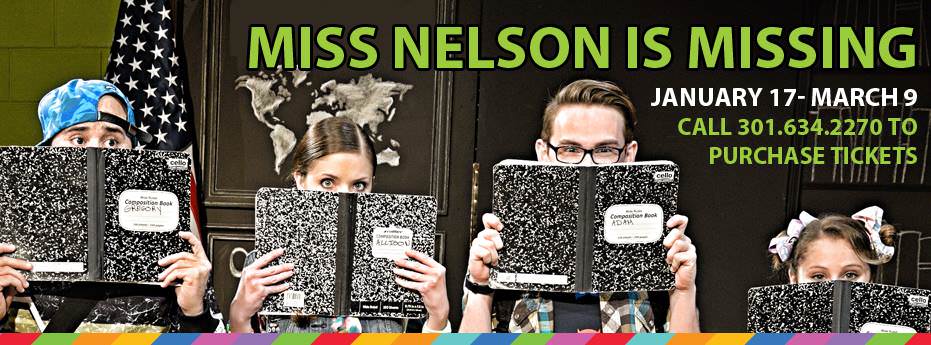I had not been to kid’s theater since I was a kid. As an inveterate theater buff, I was dimly aware there was much highly praised professional children’s theater in the DC Metro area—but I was certain this youthful pursuit was not for me. (“Good of kind” is a reviewer’s catchphrase I recall from my childhood. It meant “okay if you like that sort of thing”—which today translates as “meh.”) I had mentally ranked children’s theater alongside skateboarding, bungee jumping, and tattooing my buttocks as something that I would probably not enjoy.

Realizing my reluctance might be a tad old-farty, I decided to youthen my vista and venture into this alien genre. I dared not go unaccompanied, however; I needed protective cover; I needed to attend with an age-appropriate guest. So I was greatly relieved when sympathetic friends agreed to join me and bring their precocious ten-year-old daughter.
The offering I picked for my foray into ostensible fun was a musical called Miss Nelson Is Missing, playing through March 9th at Adventure Theatre MTC—a company now in its 62nd season (woo hoo, an old-timer too). My selection of this show by Joan Cushing (the renowned local who wrote book, music, and lyrics) was impulsive but not random. I noted that the cast features Sherry Berg, whose superb performance as Marjorie in Molotov Theatre Group‘s scathingly good Extremities (not at all a play for children!) I had greatly admired. Berg’s stretch from searing to silly I had to see.
I’ve probably cleared my throat long enough now, so I’ll come right out with it: Miss Nelson Is Missing is exuberantly entertaining, an effervescent enjoyment. From beginning to end it kept me grinning and sometimes guffawing. The ten-year-old in me loved it. As did the real ten-year-old in tow.
Of course I had to figure out why. Because that’s what I do. Writing for DCMetroTheatreArts is like giving a school report the next day except for a slightly higher reading level. So here are the top-three explanations I now scrawl in a mottled-cover, dog-eared composition book.
Reason #1: The literary source material is really interesting. Before I went, I read one of the books the show is based on, Harry Allard’s Miss Nelson Is Missing!, a slim oversize picture book first published in 1977 that I’d never heard of. The broadly comedic story is about the kids in room 207 whose teacher is nice Miss Nelson and who start out as incorrigible cutups. They’re like Romper Room rejects on a sugar rush. Then the tale takes a twist: Miss Nelson mysteriously disappears. She’s replaced by a harridan of a substitute named Miss Viola Swamp, whose steely discipline intimidates them into obedience. And boy, do they miss Miss Nelson! By the time their now-beloved Miss Nelson returns (under equally mysterious circumstances), the kids have transformed into Romper Room–approved Do-Bees. The medicinal moral of the story, which is basically “Behave or else,” goes down with heaping spoonfuls of high fructose made from corn.
Reason #2: The cast is crazy good. As the four miscreant kids, Sean McComas (Adam), Rachel Viele (Allison), Calvin McCullough (Gregory), and Sherry Berg (Cheryl) are formidably funny. The versatile Matt Dewberry, playing four different roles (custodian/narrator Pop Hanson, principal Blandsworth, museum guide AlCatraz, and detective McSmogg), makes each part a hilarious whole. And as Miss Nelson (who becomes—shhh, don’t tell the kids!—the Swamp creature), the enchanting Jessica Lauren Ball goes from goody-two-shoes to dominatrix stilettos with grace and witty grit. (As testimony to her tour-de-force transformation, the ten-year-old I was with had no clue that the Misses Nelson and Swamp were both played by Ball.)
Reason #3: The direction (Jennifer L. Nelson), musical direction (William Yanesh), and choreography (Michael J. Bobbitt) are snappy and sharp. And honorable mention goes to the apt set and projections design (Ruth Marie Tenorio), playful costume design (Aryna Petrashenko), amusing lighting design (Brittany Shemuga), and story-enhancing sound design (Kenny Neal).
Perhaps I should not have been as surprised as I was, but this production was crafted by a head-of-the-class creative team. They delivered a show that not only enthralled the kids and other grownups in the house; it changed my mind about children’s theater. Even more important, it opened my eyes to how live theater can be a lively point of reference for illuminating and edifying conversation between kids and grownups.
Here’s what I mean.
After the show was over, I asked the ten-year-old what she liked best. She promptly acted out a bunch of bits and lines from the show that popped from her uncannily retentive memory. Then I asked her what she didn’t like (the incorrigible critic in me was curious). Her two astute answers surprised me. We had been sitting in the side section of the theater’s three-quarter-round playing area, and she said she didn’t like that the actors played so much of the show to the center section. (I’m paraphrasing; she had her own way of saying this). The performance was final dress, so I guessed the issue would be fixed before press night—but what struck me was that this youngster’s observation had jibed exactly with mine, and it led to an impromptu intergenerational conversation on the point.
Her other criticism was about the scene where Miss Swamp takes the kids on a field trip to the Museum of Crime and Punishment and shows them cells where notorious criminals in U.S. history were incarcerated. I never fully got what bothered this girl about this scene (she had evidently disengaged from the show during it), but I too had found the scene off key; the momentum of the show had seemed to dip a bit. So I told her I agreed with her—and as someone without young kids of my own, I found this quick intellectual connection a kick.
The scene in question is a fabricated interpolation by adapter Cushing. It appears neither in the book Miss Nelson Is Missing nor in its 1982 sequel, Miss Nelson Is Back, upon which the show is also based. Director Nelson’s staging of the scene cannot be faulted—its comedy is dark, edgy, campy, and clever. But for younguns (the show is recommended for ages 5 and up), the scene could be disquieting. Besides which, to my dramaturgically obsessed mind, the scene unnecessarily overstates the show’s message that bad things happen to children who misbehave (and does so with ominous reference to the dubiously relevant example of adult felons). So on the authority of both this hyper-perceptive ten-year-old and yours truly, I insert a slight advisory: The Museum of Crime and Punishment scene is “good of kind,” and it would be well worth talking about afterward—among kids of all ages.
Miss Nelson is Missing plays through March 9, 2014 at Adventure Theatre MTC-7300 MacArthur Boulevard in Glen Echo Park, in Glen Echo, MD. For tickets, call (301) 634-2270, or purchase them online.






